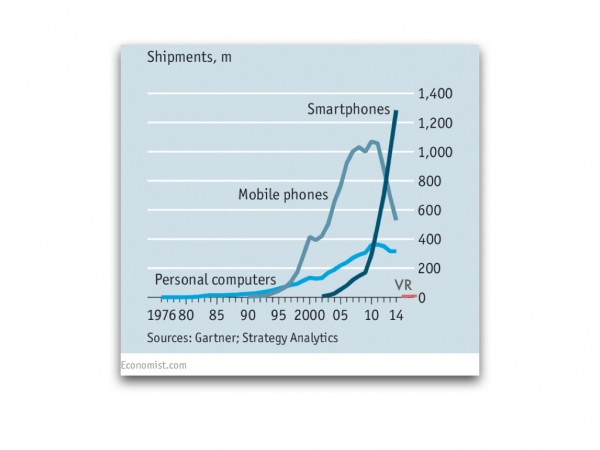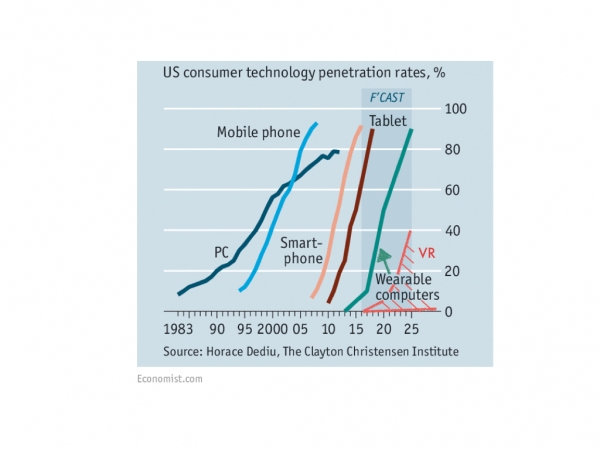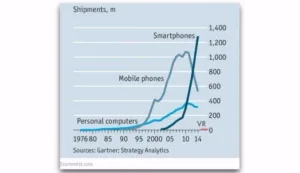Based on the number of articles written about AR / VR /MR we should all be sure that THE NEXT BIG THING has already hit us. Of course we all hear the underwhelming numbers of estimated headset sales and keep saying, it will grow next year. I am sure it will grow this year and next year and so on.
However, the real question is what will it be growing to? Please do not expect me to give you a forecast for all these new reality devices, instead I am showing what expectations for the NEXT BIG THING should be like.
The display industry is a tricky animal. On the one side it is high tech as its best with billions of dollars worth of R&D pouring in every year to push image quality to new heights while lowering prices at a constant rate. The other side is the cut throat commodity approach to building larger and larger factories to secure a higher market share. There already have been a few high level victims in this game of ‘pixels for leaders’ and I am sure we haven’t seen the end of this development. With the current political trend of more protectionism around the world, the game has gotten even more complex with the additional dimension of location. It may not be enough to make the best and cheapest display to be successful anymore, but it may become important where you make this display as well.
As a consequence, factory sizes matter when it comes to the display industry. Driven by strong government support, Asian countries have established an economic leadership that could easily described as a monopoly in terms of display manufacturing. Since there is more than one country involved, we have never experienced the negative side of a monopoly, such as poor products with no technology improvements for high prices.
With large display factories ruling the industry, the first question for any new display development is ‘market potential’. Tell me how many displays you are going to buy and I will tell you how much effort we will see from the display manufacturers.
On the other side is the head mounted display developer who needs displays and other components with very specific requirements to build a better headset. We often talk about the number of pixels needed to create a larger field of view in a VR headset or the brightness requirements for a AR display. All these requirements are easy to fulfil if any of the displays already in the market have these specs. If not, someone has to convince a display maker to develop a new display based on the ‘market potential’ for A-,M-,V-R devices.
If this is all true, take a look at the following graph from the Economist with a small addition from yours truly to show you the gap between the expectations from the display manufacturers and the reality for head mounted display developers.
 Source: The Economist – Computing Device Shipments
Source: The Economist – Computing Device Shipments
The shipments of computing devices gives you an idea of volumes that would be considered ‘interesting’ by the display manufacturers. On this scale, VR sales so far are basically non-existent. Doubling the million units or so from 2016 is still not great. If we double headset sales every year we are looking at around 20 million by 2020. This would still look anaemic on this chart.
When we take one step back and look at what drives these shipment numbers, it is clearly the adoption by the consumer that drives all of this. The following graph show some consumer technology penetration curves for the USA. Please keep in mind, market penetrations are different from country to country and from device to device.
 Source: The Economist – US Technology Penetration
Source: The Economist – US Technology Penetration
From a very simple standpoint the adoption rate all over the world drives the global shipments if we forget replacement sales for the moment. In a new technology like head mounted displays, this seems a fair assumption for the first few years with a strongly growing technology adoption. If there is no adoption growth, replacement sales will be the determining factor, but we will not be talking about the NEXT BIG THING then either.
So what is driving consumer adoption? This is really the question here. Is it better imagery, a low price, interesting content, or the sexiness of the product? As always, it will be a balance and combination of all the above. What we know up to now is that nobody has hit that magic ultimate combination so far. I believe this mixing of various aspects is where Apple has seemed to shine in recent years. So far, Apple has not had any reality headset in the market. According to a lot of rumors they are working on it, but so far nothing is in the market. Apple entering this market may be a game changer for consumer interest.
When we look at the consumer adoption for VR, we are at “0” right now, and we need something to spark the adoption to make people believe that they need it. And that is where I believe we have an issue. Going from a feature phone to a smartphone or from a laptop to a tablet are rather small steps for the consumer’s imagination. Even wearable computers are somewhat intuitive if you see them as a combination of a smartphone and a wrist watch for example. In other words, they are a combination of existing form factors.
On what existing form factor is the A-,M-, V-R headset based? If you say, of course, a combination of a smartphone and glasses you need to realize that many people needing glasses are using contact lenses or go through eye surgery to avoid wearing them. That does not point at something that people in general perceive as sexy or cool. In addition, when we remember that wearing glasses was one of the issues with 3D TV that led to its downfall I would see the glasses form factor as a definite barrier to adoption.
This could be one strike against the expected fast adoption by all consumers. Without fast adoption by consumers we will not see sales numbers that can convince display makers and other technology developers (optics, semiconductors, batteries, software, etc.) to invest heavily into the NEXT BIG THING. By the way, I do believe that all these realty headsets will eventually create a sizeable technology market that can demand all these specialized components, but I do not believe that this will happen within the next few years. I think we will have to keep reporting on all the important steps forward towards the ultimate headset and keep asking ‘are we there yet’? – NH

